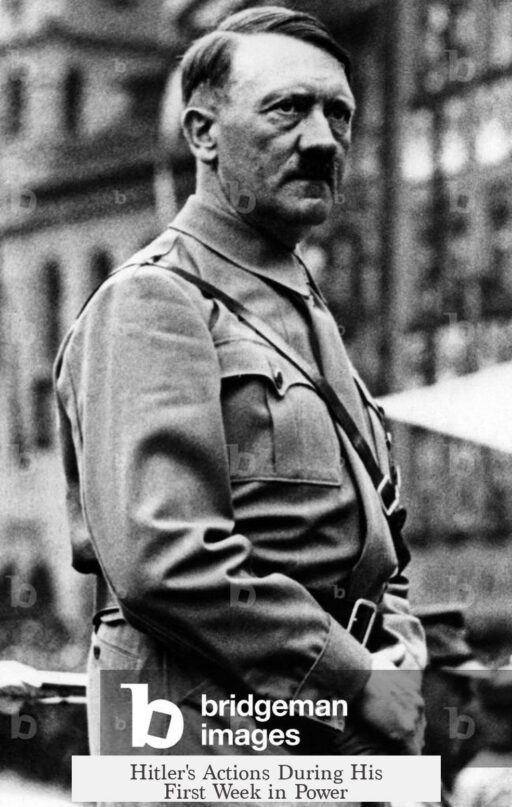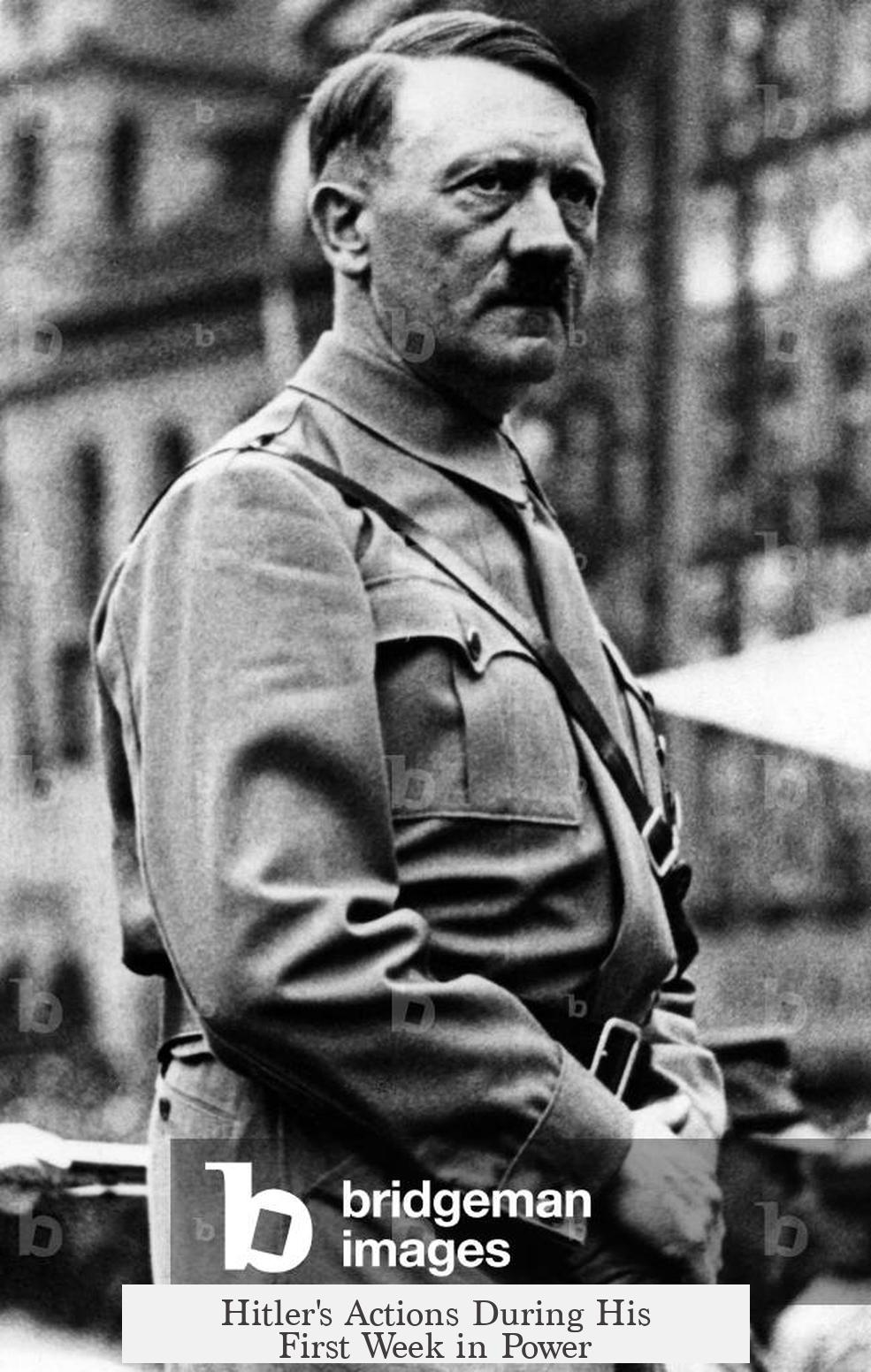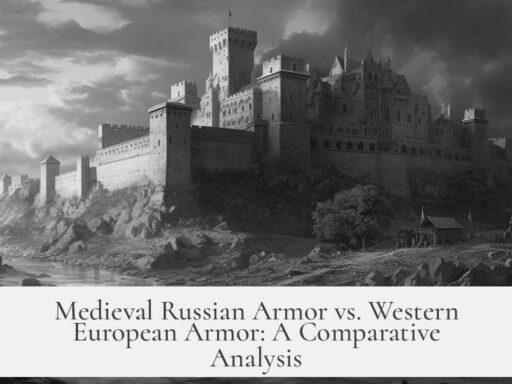In Hitler’s first week in power, he set key foundations for the rapid Nazi transformation of Germany’s government, mainly by securing control over police forces, beginning the suppression of opposition, and initiating steps to dismantle parliamentary democracy. Although this initial period did not immediately end democracy, it marked the start of a swift, authoritarian consolidation culminating in dictatorship within months.
Hitler became Chancellor on January 30, 1933, appointed by President Hindenburg. At this point, the Nazi party held only three cabinet positions, including critical control of the police through Wilhelm Frick as Minister of the Interior and Hermann Göring as Minister without portfolio. The first day included a large torchlight rally in Berlin, demonstrating Nazi strength but framed as support for Hindenburg, avoiding overt disruption of traditions. This careful public staging helped legitimize the new regime.
Immediately, Hitler took political steps to strengthen his position. On January 31, the Reichstag was dissolved and new elections were called for March 5. He simultaneously gained authority to rule by emergency decree, a legal framework enabling the bypass of parliamentary consent. The following days saw appointments, such as nationalist paramilitary leader Franz Seldte as Labor Minister, and measures forbidding Communist demonstrations.
Hitler acted decisively to neutralize opposition. He halted police investigations into Nazi paramilitary groups before his Chancellorship. Importantly, he created an auxiliary police force composed of Nazi stormtroopers, protecting them under the state’s authority. This move facilitated the persecution of opponents under the guise of law enforcement. On February 4, a cabinet decree permitted detention without trial of persons resisting Nazi stormtroopers for up to three months. Social Democratic newspapers faced bans, and political arrests escalated as Nazi members functioned as auxiliary policemen, targeting Communists and left-wing figures.
Parallel to suppressing opposition, Hitler engaged the military leadership to ensure their neutrality or support. Within days, he promised the army key goals like overturning the Treaty of Versailles, restoring conscription, and combating Marxism. Conservative politicians initially underestimated Hitler, thinking they could control him through Hindenburg. Yet these assurances positioned the military as tacit allies or at least as passive onlookers during Nazi consolidation.
Throughout the week, street violence occurred, with Nazi paramilitaries clashing against Communists. While leftist groups generally avoided confrontation fearing crackdown, Nazi rallies and intimidation pleased many Germans craving order amid political chaos. Public opinion was thus mixed but included significant support for Hitler’s assertiveness.
| Day | Date | Key Actions |
|---|---|---|
| 1 | January 30, 1933 | Hitler appointed Chancellor; appointed two Nazis to cabinet; torchlight rally with 60,000 in Berlin. |
| 2 | January 31, 1933 | Dissolved Reichstag; called elections for March; gained emergency decree powers. |
| 3 | February 1, 1933 | Appointed Franz Seldte as Labor Minister; condemned Marxism in speech. |
| 4 | February 2, 1933 | Banned Communist demonstrations; met military leaders pledging support. |
| 5 | February 3, 1933 | Acknowledged rearmament risks provoking France. |
| 6 | February 4, 1933 | Issued decree banning political meetings; allowed detention without trial up to 3 months. |
| 7 | February 5, 1933 | Attended funerals of SA chief and policeman killed in riots. |
This week was not, in itself, the definitive collapse of democracy. Instead, it laid the groundwork for the swift deterioration that followed, especially after the pivotal Reichstag Fire on February 27, 1933. That event enabled Hitler to convince President Hindenburg to issue the Reichstag Fire Decree, suspending civil liberties and allowing mass arrests without trial. Subsequently, the Nazis used these powers and police control to arrest Communist and Social Democrat legislators, intimidate opposition, and secure passage of the Enabling Act on March 23, 1933.
The Enabling Act gave Hitler the authority to enact laws without parliamentary approval, effectively establishing a legal dictatorship. Within five months, the Nazis banned all opposition parties, dissolved trade unions, and sent political adversaries to concentration camps. By mid-1933, Germany was a one-party state ruled by the Nazi regime.
Overall, Hitler’s first week in power initiated crucial steps:
- Securing police control to protect Nazi paramilitaries and suppress opponents.
- Banning opposition demonstrations and media outlets.
- Calling new elections to legitimize Nazi authority.
- Engaging military leaders to secure neutrality or support.
- Setting the stage for legal mechanisms to eliminate democracy.
This time was the start of a rapid and systematic destruction of democratic institutions rather than an immediate seizure of absolute power.
- Hitler’s first week was foundational, not yet fully dictatorial.
- Police control and legal decrees began suppressing opposition.
- Conservative and military leaders underestimated Hitler’s ambitions.
- Violence and propaganda increased in the streets and media.
- By March, laws granted Hitler powers to destroy democracy.




